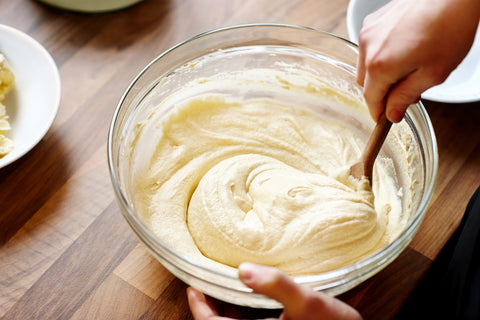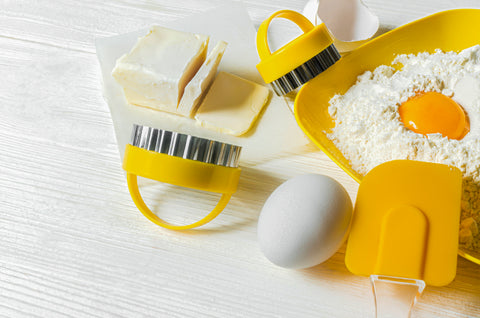The Eccles cake is also known as the 'Squashed Fly Cake' – this is because it is a flaky cake stuffed with small dried currants that look like flies tumbling out of the little round cakes. Eccles cakes are also dusted with demerara sugar, which gives them a delicious and different taste.
History of Eccles Cakes

Eccles cakes are named after the town of Eccles in Lancashire, England, now known as a town in the City of Salford, Greater Manchester. Although they were initially made way back, James Birch was the first to sell Eccles cakes in the Eccles town centre in 1793. As early as 1818, they were even being shipped to the West Indies and the United States because they had become so popular.
However, if the cakes have survived in English cuisine, it is mainly because of a factory on the outskirts of Manchester, five miles from Eccles, where the cakes were first made. Real Lancashire Eccles Cakes is owned by the Edmonds family and is the largest producer of Eccles cakes in the world. They have been creating the pastries for about 75 years.
These pre-packaged, commercially available cakes are extremely rare delicacies as they are very delicious. This is because they are primarily handmade, even if they are mass-produced. They use special currants from Vostizza, Greece, that are hand-picked and dried before being packaged.
While these cakes are readily available, you can make them at home, too. Here is a recipe for British Eccles Cakes:
Ingredients:
For the Pastry
- 225g all-purpose flour
- 125g unsalted cold butter cold - diced
- A pinch of salt
- Cold water
For the Filling
- 50g unsalted butter, softened
- 75g caster sugar
- 150g currants
- ½ tsp ground allspice
- ½ tsp ground nutmeg
Instructions:
Preparing the Pastry-

- Take a large bowl, sift the flour and add a pinch of salt to it. Add the diced butter to the flour.
- Rub the butter into the flour until it looks like breadcrumbs.
- Add a small amount of cold water (approximately 2-3 tablespoons) gradually while mixing to create dough. Take care not to overly mix it - simply combine the dough.
- Refrigerate the pastry for at least 30 minutes after wrapping it in plastic wrap.
Preparing the Filling-
- Take another bowl and mix together the softened butter, currants, caster sugar, ground nutmeg and ground allspice till they are well combined.
Assembling the Eccles Cakes:
- Make your oven preheated to 200°C OR 392°F.
- Nwxt, roll out the chilled pastry to a thickness of around 1/4 inch on a floured surface.
- Make 4-inch-diameter rounds from the pastry by cutting them with a round mould.
Fill and Seal the Cakes:
- Fill the middle of each pastry round with a dollop of the currant filling.
- The pastry's edges should be dampened with a little water before being folded inward to enclose the filling and form a semi-circular shape.
- Turn the cake over so the seam side is down after sealing the sides securely.
- On the top of each cake, make three diagonal slits using a sharp knife.
- For a golden finish, lightly brush some milk or beaten egg on the cakes' tops.
Bake:

- Arrange the prepared Eccles cakes on a baking sheet covered with parchment paper.
- The cakes should be baked in the preheated oven for around 15-20 minutes or until crisp and golden brown.
- Once they are done, allow them to cool down on a wire rack. Eccles cakes are best enjoyed when they are freshly made out of the oven. They go well with afternoon tea or simply as a snack for the evening or as a dessert.
Tips for Making Eccles Cakes

Follow these tips to ensure you make the Eccles cakes perfectly:
Chill the Pastry
Before rolling out your pastry, make sure the pastry dough is chilled. This contributes to the flaky texture.
Use Cold Butte
The pastry should be made with chilled, chopped butter. It further assists in making the pastry nice and flaky.
Do Not Overmix
Be careful not to overly mix the butter and flour when making the pastry. To avoid harshness, stop once it resembles breadcrumbs.
Generous Filling
Fill the pastry with just enough currant filling, but do not overfill, as this could cause leaks while baking.
Seal Edges Securely
Seal the dough rounds' edges properly to stop the filling from seeping out as they bake.
Flour for Rolling
To keep the pastry from sticking to your rolling pin and workspace, dust it generously with flour.
Even Thickness
Roll out the pastry evenly to about ¼ inch so the baking is done equally.
Scoring
Use a sharp knife to cut three diagonal slices on the top of each cake. This let steam to escape when baking and gives a nice appearance – it was done in the olden days and gives a nice traditional look.
Egg Wash
Before baking, brush the tops with a little milk or beaten egg to provide a glossy, golden finish.
Baking Time
Eccles Cakes should be crisp and golden brown, but overbaking them will make them too hard.
Enjoy Fresh
Eccles cakes should be had fresh as they are flakiest on the day they are baked.
Serve Traditionally
Eccles Cakes are often served at room temperature. But some people prefer them slightly warm with ice cream or clotted cream on top.
Following these tips, you can create delicious Eccles Cakes with a perfect balance of flaky pastry and sweet currant filling.
British Eccles cakes are delicious sweets whose origins date back centuries and are a monument to culinary history. Eccles Cakes are a favourite option for afternoon tea or a sweet snack because they offer the ideal blend of textures and flavours.


 Christmas 2025
Christmas 2025
 Frozen Food
Frozen Food
 Baking
Baking
 Beans, Peas, Soups & Tins
Beans, Peas, Soups & Tins
 Biscuits, Crackers & Cookies
Biscuits, Crackers & Cookies
 Candy / Sweets
Candy / Sweets
 Crisps & Snacks
Crisps & Snacks
 Chemist / Pharmacy
Chemist / Pharmacy
 Desserts
Desserts
 Gravy, Stock & Paste
Gravy, Stock & Paste
 Haggis
Haggis
 Indian Sauces, Paste and Pickle
Indian Sauces, Paste and Pickle
 Jams & Preserves
Jams & Preserves
 Poppy Appeal
Poppy Appeal
 Pot Noodles & Super Noodles
Pot Noodles & Super Noodles
 Scone Mix
Scone Mix
 Gluten-Free / Free From
Gluten-Free / Free From
 Tea Accessories
Tea Accessories
 Teapot & Tea sets
Teapot & Tea sets
 Tea For One
Tea For One
 Sugar & Creamer
Sugar & Creamer
 Tableware
Tableware
 Serveware
Serveware
 Plates & Trays
Plates & Trays
 Bowls
Bowls
 Cups & Saucers
Cups & Saucers
 Mugs
Mugs
 Silverware
Silverware
 Dinnerware - Accessories
Dinnerware - Accessories
 Dinnerware - For Pets
Dinnerware - For Pets
 Victoria Eggs - Hand-Drawn UK Homeware
Victoria Eggs - Hand-Drawn UK Homeware
 Jewelry & Accessories
Jewelry & Accessories
 Sale
Sale
 Christmas Gifts
Christmas Gifts

